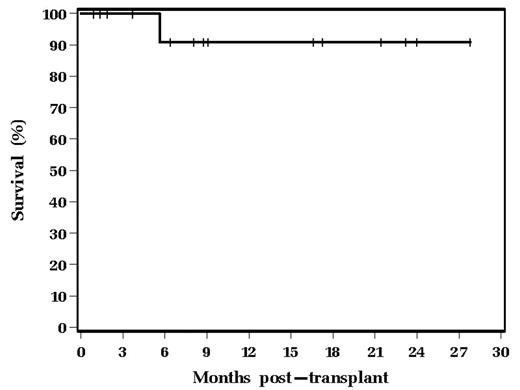Abstract
High dose chemotherapy and autologous stem cell transplantation (ABMT) is the treatment of choice for most patients with recurrent Hodgkin’s Disease (HD). Cure rates approach 50% for patients with favorable prognostic features, but ABMT salvages only approximately 20% of patients with very high-risk features. Such patients include those who progress through initial chemotherapy, and those relapsing rapidly after initial chemotherapy. Traditional ablative allogeneic transplantation has not improved the outcome for such high-risk patients, largely because of high transplant-related mortality. Non-myeloablative allogeneic transplantation may have a role for patients with less malignant HD and is currently under study. Tandem autologous transplantation may prove to be superior for such high-risk HD patients, analogous to data seen in multiple myeloma. This study represents a summary of all 15 high-risk HD patients treated with a tandem autologous approach at our institution. Patients were treated from 11/6/02–6/7/05 with a median follow-up of survivors of 8.9 months (range, 0.9–27.8 months). Eligibility into this study included disease progression during initial chemotherapy or relapse within one year of initial chemotherapy. Patients received etoposide plus G-CSF for stem cell mobilization with a minimum of 4 x 106 CD34+ cells/kg collected. The first transplant was with single agent Melphalan (150 mg/m2). After an interval of 4–8 weeks, the second transplant consisted of BCNU, etoposide and cyclophosphamide (CBV). 15 patients have been entered into the study, median age 29 years. 20% had prior radiation therapy; all had failed prior chemotherapy, 14/15 had been treated with ABVD and 1 had Stanford V. 66% had a response (usually partial) to salvage chemotherapy and 33% did not. Median number of days from the 1st transplant to the 2nd transplant was 46 days. Median CD34+ cell dose collected was 18.3 x 106 cells/kg (range, 4.49–29.04). 100% of patients completed the planned treatment. 100-day survival was 100%. To date, 40% have relapsed and 60% are disease free. Of relapsing patients, median time from the 2nd transplant to relapse was 100 days (range, 44–491 days). The overall survival curve is shown below:
We retrospectively identified 18 comparable high-risk HD patients who had previously received a single autologous transplant at our institution from 1988 to 2003. The relapse rate post ABMT for these patients was 67%. Median time to relapse was 5.8 months (range, 1.5–45.4 months). In conclusion, we believe that tandem autologous transplantation is promising for very high-risk HD patients. Of those patients destined to relapse after tandem transplant, the majority do so within 6 months of therapy. Therefore, a rather short follow-up is still indicative of favorable results, given that the majority of treated patients on this trial are currently alive and disease free.
Author notes
Corresponding author


This feature is available to Subscribers Only
Sign In or Create an Account Close Modal